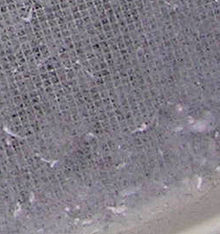Lint (material)
| Lint | |
|---|---|

Lint accumulation in the screen of a clothes dryer
|
|
| Type | Visible accumulations of textile fibers and other materials |
Lint is the common name for visible accumulations of textile fibers and other materials, usually found on and around clothing. Certain materials used in the manufacture of clothing, such as cotton, linen, and wool, contain numerous, very short fibers bundled together. During the course of normal wear, these fibers may either detach or be jostled out of the weave of which they are part. This is the reason that heavily used articles like shirts and towels become thin over time, and why these particles collect in the lint screen of a clothes dryer. Because of their low surface area, static cling causes fibers that have detached from an article of clothing to continue to stick to one another and to that article or other surfaces with which they come in contact. Other small fibers or particles also accumulate with these clothing fibers, including human and animal hair and skin cells, plant fibers, and pollen, dust, and microorganisms. The etymology of the modern word "lint" is related to "linting", the term used for the cultivation of the shorter fibers from the cotton plant (Gossypium), also called "lint", from which lower-quality cotton products are manufactured. Lint is composed of threads of all colors, which blend hues and may appear to be a uniform grey.
Dryer lint is lint generated by the drying of clothes in a clothes dryer; it typically accumulates on a dryer screen. Underwriters Laboratories recommends cleaning the lint filter after every cycle for safety and energy efficiency.
Navel lint (also known by names such as navel fluff, belly button lint, belly button fluff, and dip lint) is an accumulation of fluffy fibers in the navel cavity. Many people find that, at the beginning and end of the day, a small lump of fluff has appeared in the navel cavity. This lint is an accumulation of cloth fibers that are scraped by body hair. The reasons for its accumulation in the navel are a subject of speculation. A likely hypothesis is that rubbing of navel hairs and clothing contributes to a build-up of static electricity, resulting in the collection of clothing fibers and to a lesser extent, dead skin cells.
...
Wikipedia
